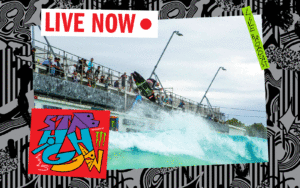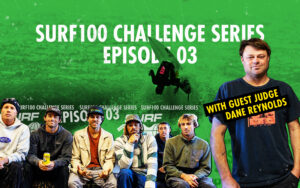Capturing New York Surfing’s Crazy Cast Of Characters And Cold, Cruel Charm
“Ice Cream Headaches” is a gorgeous addition to any discerning surfer’s book shelf.
There are few lineups with as broad an array of interesting characters bobbing in them as the rock groin sandbanks, peaky A-frame beach breaks, and rocky points between Coney Island and the Montauk lighthouse.
And perhaps no one has done such a thorough and exquisite job of capturing those characters and their diverse environments—from Lower east side flats, Brooklyn brownstones, and Rockaway shaping shacks, to Upper West Side writing studios, Williamsburg lofts, and Montauk bungalows—than Julien Roubinet and Ed Thompson’s Ice Cream Headaches.
We caught up with Julien and Ed to talk about the hefty volume, and for a peek at some of Julien’s polished photography.

The Pit, Long Island.
Photography
Julien Roubinet
Stab: How did you guys avoid the typical “Did you know you can be a surfer and live in NEW YORK!I” angle that these projects often take, instead trying to really capture the scene there.
Julien: Once you realize the surf is actually real, you get over it pretty quick and start grasping what the real gift is: the concentration of creativity and talent encountered at the beach during pre-office hours.
When we started the project, the coverage was mainly through social media, a couple of dying print magazines, Surfline features from swells. Just surf porn. It’s very cool to see who scored the best waves (usually the same group of people!), sometimes triggering that FOMO, but it gets repetitive. We thought it would be interesting to dig deeper into people’s lives and document what is usually overlooked—like finding out that Balaram had an alligator at his house). For me, since I’m not coming from purely a surf photography background, it made sense too.
Ed: We just wanted to get beyond that. It’s a valid point and for most people it is surprising, but it’s not interesting to just stop there, especially not for surfers. We already know!
There are people here for whom surfing is deeply woven into their daily lives—they check the ocean or the charts every single day. When it’s on, they drop everything and just go, because with swells here, it’s on for 3-4 hours, not 3-4 days.
Surfing here demands a different kind of commitment. I don’t think typical surf media does a great job of representing that passion, because it’s generally focused on telling the story that there is surf here, or of XYZ surfer’s latest Instagram edit. It’s cool, but we wanted to dig deeper. I think that motivation maybe came from being outsiders. We came at it with an outside perspective and a huge hunger to learn.

“There are people here for whom surfing is deeply woven into their daily lives—they check the ocean or the charts every single day. When it’s on, they drop everything and just go, because with swells here, it’s on for 3-4 hours, not 3-4 days.”
Photography
Julien Roubinet
What did you think the New York surf scene was going to be like before you moved?
Julien: I had no idea there was one, but quickly realised after Ed suggested this project, the potential around and beyond it.
Our first ambition was to cover the coast from New Jersey to Maine, but that would have been foolish. As Ed pointed out in the introduction of the book, the scene is so rich in NY and NJ that you could fill another 200 pages with a very different cast of characters.
Ed: I didn’t know much about it, but I figured there must be more opportunity in New York than in London, and at least it was near the ocean! I found out about the surf scene right before I moved here for work, so I packed a board at the last minute.

Rockaway Beach’s friendliest enforcer, Joey Falcone, aka Joey Clams, aka Clams, aka The Grey Ghost, in his shaping shack, aka The Clams Casino.
Photography
Julien Roubinet
Who were you most excited agreed to be photographed for the book?
Julien: It’s a difficult question. Every single story was a treat to discover.
I’d say meeting the artist Ran Ortner and experiencing his paintings in person were incredible. Beyond his talent and achievements, he is also extraordinarily cultivated and fascinating to listen to. By the end of the interview, Ed and I remained silent.
Joseph Falcone, born and raised in Rockaway Beach, was another favorite. He makes all kinds of beautiful, refined boards—but he’s known for his fishes inspired by Steve Lis. He takes his craft really seriously and unapologetically perpetuates a kind of localism that simply demands others be respectful and self-aware in the water. We got to know him over the years—he’s as kind to the people around him as he is bright.
Ed: The first person who agreed to be in the book was Michael Halsband. He put us through our paces to track him down, after we briefly met him at an event at the Patagonia store in Soho, but it was worth the work.
He seemed so out of reach given his many achievements and yet he was open, friendly and incredibly welcoming when we shot him at his studio in Manhattan. He has amazing stories and a deep love of surfing and what it means to be a surfer.
Every single one of the interviews we did was memorable and compelling in some way, even those we couldn’t fit into the book. But I think I was most excited about Halsband and Bill Finnegan, given their incredible achievements. We just knew they would have some good stories.
You guys shot Bill Finnegan right after he won the Pulitzer. What was it like spending time with that guy?
Julien: We were a bit anxious up until he welcomed us in his upper west side office. We dug straight into important matters—his thoughts on View From a Blue Moon and the recent Honolua Bay contest. Almost immediately we were nerding out about other videos, stories and spots… Our common interest rapidly eclipsed our apprehensions.
One thing about surfing I love is its ability to bring such a diverse set of people together in the water. This is especially true in New York. You’ll find artists, financiers, creative professionals, entrepreneurs and more on the same peak.
I would also add that Finnegan remains one of the most passionate people about surfing I’ve met, even after his lifetime of surfing and discovering heavy waves around the world.
Ed: I don’t often get star-struck because I feel everyone has an interesting story to tell. That said, knowing what a great writer he is, and that we’d have to do justice to his achievements was intimidating.
To echo Julien’s point about his passion, when we wrapped the interview Finnegan wanted to show us a north swell he’d been tracking in the Atlantic. It was heading for Puerto Rico, raising the possibility of a strike mission. The dates would conflict with The New Yorker staff holiday party.
“They don’t need me there…” he said.

Pulitzer Prize winner William Finnegan, in his Upper West Side office, considering bailing on the New Yorker holiday party for a winter swell in the Caribbean.
Photography
Julien Roubinet
What were you shooting with mostly? Digital, film, etc.?
All the surfing was shot on digital, with the exception of one frame of Rockaway, which was shot on a disposable camera. We shot that image on one of the first days Ed and I surfed together, and it was one of the coldest too. We came out of the water with icicles on our wetsuit hoods. We shot most of the portraits on 120mm film.

Maddie Peterson.
Photography
Julien Roubinet.

Maddie Peterson.
Photography
Julien Roubinet
Tell me that story about the cover shot.
The shot of Tripoli Paterson happened towards the end of the making of the book. Ed and I had been frustrated with missed opportunities to capture a proper swell in Montauk. After months of waiting, we finally saw something on the charts that looked good-to-epic. In true NY fashion, we escaped work commitments and bet on that swell to deliver what we were after. It arrived on Election day, 2017.
On the way to Montauk, photographer Tommy Colla, who also appears in the book, lent me his 500mm lens (which I later acquired) and a tripod. He saved the day. We crashed at Tripoli’s house in Southampton the night before, woke before dawn and raced to one of the most beautiful spots on the East End. All the locals were already in the water and absolutely shredding this perfect late-autumn swell.
We were mesmerized by the spectacle, but we were so excited we’d forgotten our coats. The wind on the bluffs was freezing, so I shot with socks on my hands and wrapped in a blanket from the car. It was an incredible day and we were on a huge high from capturing the swell. The adrenaline and excitement came crashing down as NPR announced, state by state, that Trump was taking the lead. The morning after, the waves were still great but we didn’t go surfing.

Tripoli Patterson.
Photography
Julien Roubinet.
How important is the city to the surf scene in Long Island, Rockaway, etc.
Ed: I don’t think the city is important to those surf scenes, but media often hypes the relationship between the two. There are surfers all the way along the coast from Montauk to Cape May and literally hundreds of spots with a point, jetty or sandbar that will work when there’s a swell.
New York City has a high concentration of people from all over the world, many of whom are accomplished surfers, here for some other reason. That just means there are lots of people who’ll jump on the train and get out there when it’s firing.
If anything, I’m pretty sure locals in Rockaway would rather they had a bit more space to themselves!
Jules, you’ve since left New York. What do you miss most? What would you happily forego forever?
I started surfing in New York, and one of the qualities surfers there share is their sheer interest in surf culture and history. So, learning at events, interviewing people… it was a major part of life there. I do miss nerding out with people about boards, spots, and the everlasting and unsolvable group text debates on where it will be best the in the morning, surfing with a bunch of excited, hungry friends.
The flat spells were really hard to deal with, but even with icy water, snow—the train rides were brutal—there was a certain romance to it.
You can get a signed copy of Ice Cream Headaches this weekend in New York:
Montauk,
Saturday
21st
2-6pm
–
Montauk Beach HouseLong Beach,
Sunday
22nd
6-9pm
–
Hurley Surf Club













Comments
Comments are a Stab Premium feature. Gotta join to talk shop.
Already a member? Sign In
Want to join? Sign Up